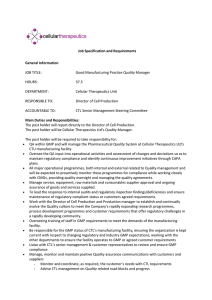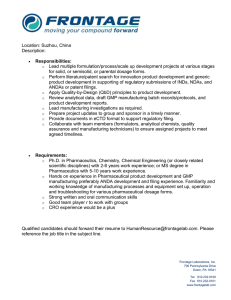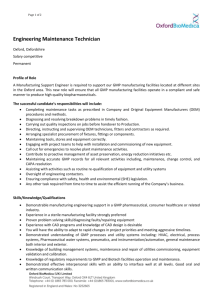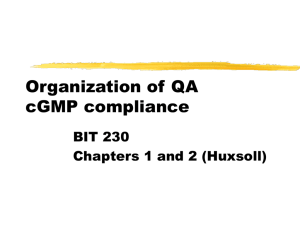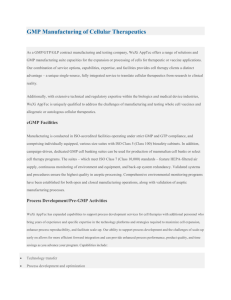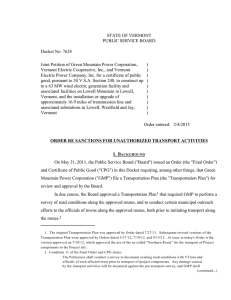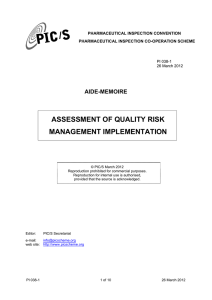GMP Updated Training Modules
advertisement
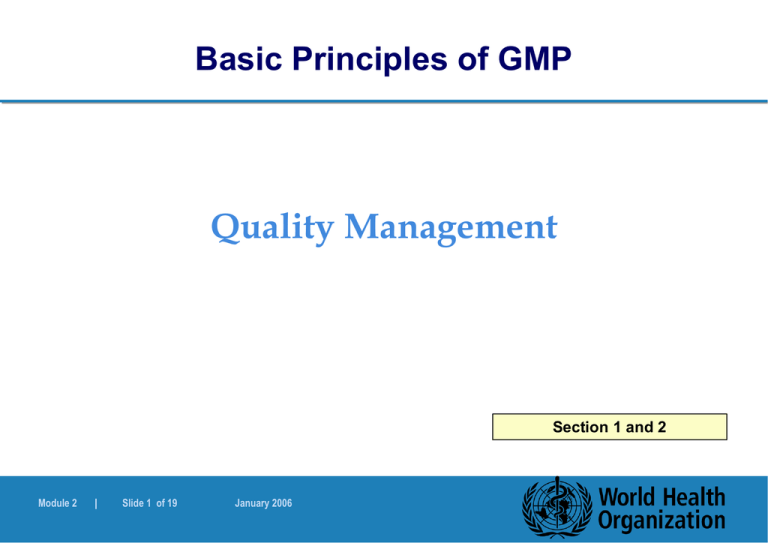
Basic Principles of GMP Quality Management Section 1 and 2 Module 2 | Slide 1 of 19 January 2006 Quality Management Objectives Module 2 To understand key issues in quality assurance/good manufacturing practices/quality control. To understand specific requirements on quality management and quality assurance including: Organization Procedures, processes and resources. To develop actions to resolve your current problems. | Slide 2 of 19 January 2006 Quality Management Quality relationships Quality Management Quality Assurance GMP Section 1 and 2 Production and Quality Control Module 2 | Slide 3 of 19 January 2006 Quality Management Philosophy and essential elements What is Quality Management? The aspect of management function that determines and implements the “quality policy” The overall intention and direction regarding quality, as formally expressed and authorized by top management Module 2 | Slide 4 of 19 January 2006 Quality Management Quality Management The basic elements are: An appropriate infrastructure or “quality system” encompassing the organization structure, procedures, processes and resources The systematic actions necessary to ensure adequate confidence that a product (or service) will satisfy given requirements for “Quality” The totality of these actions is termed “Quality Assurance” Module 2 | Slide 5 of 19 January 2006 Quality Management Quality Management Quality assurance is a management tool In contractual situations, it also serves to generate confidence in a supplier QA, GMP and Quality Control are interrelated aspects of Quality Management They are described on the following slides in order to emphasize their relationship and their fundamental importance to the production and control of pharmaceutical products Module 2 | Slide 6 of 19 January 2006 Quality Management Principles of Quality Assurance (QA) Wide-ranging concept covers all matters that individually or collectively influence the quality of a product Totality of the arrangements to ensure that the drug is of the right quality for the intended use Quality Assurance incorporates GMP and also product design and development which is outside the scope of this module 1.1 Module 2 | Slide 7 of 19 January 2006 Quality Management QA System should ensure: Products are designed and developed correctly Complying with, e.g. GMP, GCP, GLP Production and control operations are defined Managerial responsibilities are defined In job descriptions The manufacture, supply and use of correct starting and packaging materials 1.1 a- d Module 2 | Slide 8 of 19 January 2006 Quality Management QA System should ensure (2): Controls are performed, including intermediates, bulk, calibration and validation Correct processing and checking of the finished product Products are sold/supplied only after review by the authorized person Complying with marketing authorization, production and QC requirements Proper storage, distribution and handling 1.1 e - h Module 2 | Slide 9 of 19 January 2006 Quality Management QA System should ensure (3): Procedures for self-inspection and/or quality audits Reporting, investigation and recording of deviations System for change control/approval Regular evaluation of product quality to verify consistency and continued improvement 1.1 i - l Module 2 | Slide 10 of 19 January 2006 Quality Management Quality Assurance Manufacturer is responsible for the quality of the product Fit for intended use Comply with marketing authorization Safety, efficacy and quality Senior management and commitment of all staff 1.3 Module 2 | Slide 11 of 19 January 2006 Quality Management Quality Assurance Requires a comprehensively designed and well implemented QA system Fully documented, and effectiveness monitored Competent personnel, sufficient premises, equipment and facilities 1.3 Module 2 | Slide 12 of 19 January 2006 Quality Management Good Manufacturing Practices (GMP) That part of QA that ensures that products are consistently produced and controlled Quality standards Marketing authorization Aim: Diminishing risks that cannot be controlled by testing of product Contamination and cross-contamination Mix-ups (confusion) 2.1 Module 2 | Slide 13 of 19 January 2006 Quality Management Basic Requirements for GMP – I Clearly defined and systematically reviewed processes Qualification and validation is performed Appropriate resources are provided: Qualified and trained personnel Premises, space, equipment and services Materials, containers, labels Procedures, storage, transport Laboratories and in-process control 2.1 a - c Module 2 | Slide 14 of 19 January 2006 Quality Management Basic Requirements for GMP – I Clear, written instructions and procedures Trained operators Records of actions, deviations and investigations Records for manufacture and distribution Proper storage and distribution Systems for complaints and recalls 2.1 d - j Module 2 | Slide 15 of 19 January 2006 Quality Management Group session – I How many GMP deficiencies can you find in the photographs in the handout? Module 2 | Slide 16 of 19 January 2006 Quality Management Group session II Imagine you are inspecting a pharmaceutical company for compliance with GMP Consider the situations in the next slides which may have impact on a company’s quality management programme Describe the action to be taken in each case Module 2 | Slide 17 of 19 January 2006 Quality Management Issues – I Quality Management manual not established in writing Limited human resources Lack of qualified people Processes not properly validated Poor SOPs or standard batch documentation More consideration to cost than quality Family members in key positions of authority Module 2 | Slide 18 of 19 January 2006 Quality Management Issues – II Substandard materials deliberately purchased Technical staff not involved in purchasing Inability to re-export substandard materials Owner insists on selling rejects Corruption No commitment to training Module 2 | Slide 19 of 19 January 2006


